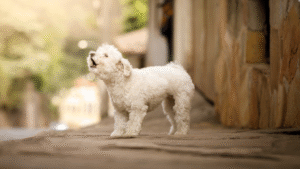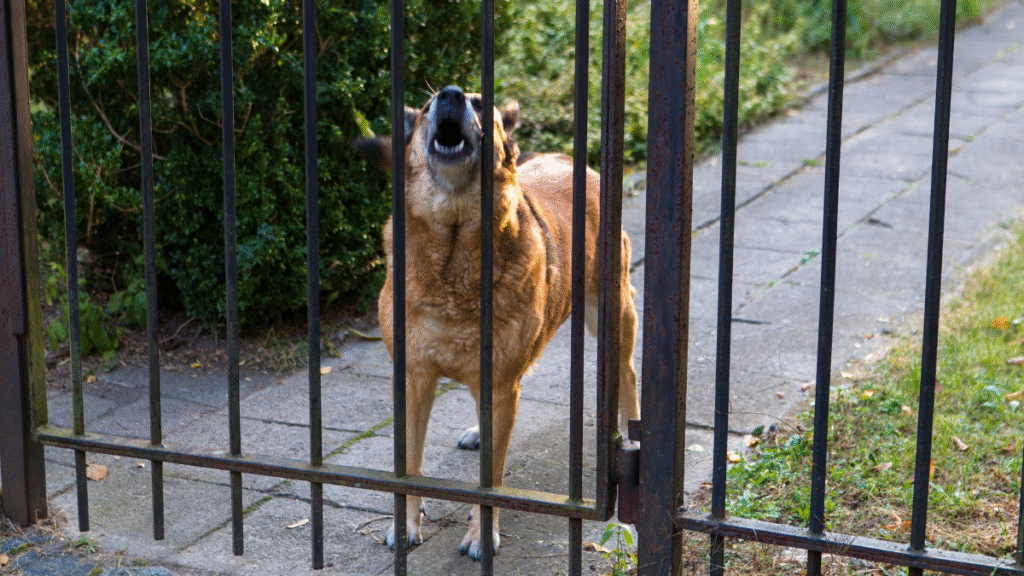First, it’s important to understand that when your dog barks, they’re not doing it out of spite or malice. Dogs bark to communicate, and the doorbell is a big, recognizable trigger for many of them.
However, there are specific reasons your dog barks when they hear that sound:
Why Dogs Bark:
1. Alert Barking
A doorbell often tells a dog that someone or something new is coming. For your dog, alerting you that someone is at the door feels like part of their job — and many dogs take it seriously.
2. Territorial Behavior
The ringing doorbell can also signal to your dog that an intruder is trying to enter their home. Barking is their way of protecting you and defending their territory.
3. Excitement or Anticipation
Some dogs bark simply because they associate the doorbell with fun — visitors, walks, or deliveries. The sound triggers excitement, and barking becomes their way of expressing it.
4. Anxiety or Fear
For more sensitive dogs, the doorbell can feel like a sudden, loud, and unpredictable intrusion. If your dog is easily startled or anxious, they may bark out of fear or discomfort.
5. Learned Behavior
Dogs can also learn to bark because it gets a reaction. If you rush to the door, yell “Quiet!” or scold them, they learn that barking brings attention — which reinforces the behavior.

Step 1: Figure Out Why Your Dog Barks
Not all barking is the same, and the reason behind your dog’s barking will affect how you fix it.
Observe your dog’s body language:
-
If their tail is up, ears forward, and they run to the door, they’re likely excited or territorial.
-
If they back away, whine, pace, lick their lips, or hide, the barking is likely fear-based.
Understanding what triggers your dog’s reaction is the first step in choosing the right training approach.
Step 2: Manage the Environment
While you train your dog, managing their environment can help reduce triggers and stress.
-
Turn down the doorbell volume or replace it with a softer sound.
-
Use a baby gate to keep your dog away from the front door during training.
-
Close curtains or blinds if your dog also barks at people outside.
-
Ask visitors not to ring the doorbell — they can text or call instead.
Making these small adjustments helps you regain control and limit doorbell barking while you work on long-term training.
Step 3: Train an Alternative Calm Behavior
The most effective way to stop your dog from barking at the doorbell is to teach them an alternative behavior. Since a dog can’t bark and sit quietly at the same time, replacing barking with calm behavior helps them learn to ignore the sound.
Teach a “Go to Mat” or “Place” Command
-
Choose a cue word.
Use “Go to your mat” or “Place” to send your dog to a designated spot (like a bed or mat) when they hear the doorbell. -
Train the command first.
Practice sending your dog to their mat using treats and praise. Reward calm behavior such as lying down or staying relaxed. -
Add the doorbell sound.
Once your dog knows the command, introduce the sound of the doorbell. Record your doorbell or play a similar sound from your phone.-
Ring the bell at a low volume.
-
Immediately cue your dog with “Go to your mat.”
-
Reward calm, obedient behavior.
-
-
Gradually increase difficulty.
Over several sessions, make the sound louder and more realistic. With repetition, your dog will learn that the doorbell means “go to your mat and relax” instead of “run and bark.”
Consistency is key. Practice daily in short sessions, and be patient — it can take several weeks before your dog’s calm response becomes automatic.

Step 4: Desensitize Your Dog to the Doorbell
Desensitization helps your dog stop reacting to the sound altogether by changing how they feel about it.
How to Desensitize Your Dog
-
Play the doorbell sound softly.
Start at a volume so low that your dog hears it but doesn’t react. -
Reward calm behavior.
When your dog remains relaxed, give them a treat or verbal praise. -
Gradually increase the volume.
Over multiple sessions, raise the volume — but never high enough to trigger barking. -
Add movement.
Once your dog can stay calm while hearing the bell, practice walking to or opening the door. -
Add real-life practice.
Ask friends or family to ring the bell so your dog learns to stay calm during real visits.
Step 5: Use Positive Reinforcement
Positive reinforcement — rewarding good behavior immediately — is the foundation of effective dog training.
Reward your dog when they stay calm, go to their mat, or remain quiet when the doorbell rings. Use treats, praise, or a favorite toy.
Avoid punishment. Yelling or scolding only adds stress and excitement, reinforcing the barking. Instead, calmly redirect and reward quiet behavior. Over time, your dog will learn that quiet equals rewards, while barking gets no attention.
Step 6: Teach “Quiet” on Command
Teaching your dog a “Quiet” cue can be helpful both for doorbell barking and other situations.
How to Teach the “Quiet” Command
-
Allow your dog to bark a few times.
-
Say “Quiet” in a calm, firm tone.
-
The instant your dog stops barking — even for a second — say “Yes!” and reward them.
-
Repeat frequently, gradually waiting longer for quiet before rewarding.
Combine this cue with your doorbell training for even faster progress.

Step 7: Remain Consistent and Patient
Consistency is crucial. If you sometimes allow barking and sometimes correct it, your dog will be confused. Everyone in your household should follow the same rules and cues.
Training takes time and repetition. It may take several weeks or even a couple of months before your dog fully stops barking at the doorbell. Patience and persistence will pay off.
Bonus Tips to Help Stop Barking
-
Walk your dog daily.
A tired dog is a calm dog. Regular exercise and mental enrichment reduce pent-up energy that can lead to barking. -
Use interactive toys.
Toys that challenge your dog mentally can keep them occupied and less reactive. -
Play soft music or white noise.
Background sounds can mask sudden noises like the doorbell and reduce startle reactions. -
Try a doorbell desensitization app.
Many apps let you practice controlled training sessions conveniently at home. -
Hire a professional trainer.
If your dog’s barking is severe or linked to anxiety, consider working with a certified dog behaviorist or positive reinforcement trainer.

Common Mistakes to Avoid
-
Yelling at your dog: It only adds to the excitement.
-
Using shock or spray collars: These aversive methods create fear and anxiety and often make the problem worse.
-
Being inconsistent: Everyone in the home must respond the same way to barking.
-
Skipping desensitization: Without addressing the trigger, barking won’t improve long-term.
The Bottom Line
Training your dog to stop barking at the doorbell takes time, patience, and consistency. Remember, your dog isn’t barking out of defiance — they’re reacting to a sound they don’t fully understand.
By using positive reinforcement, desensitization, and consistent training, you can teach your dog that the doorbell isn’t a threat or an invitation to chaos. Soon, instead of a barking frenzy, you’ll have a calm, confident dog who either ignores the bell or waits quietly for your cue.
Teaching your dog to stay calm at the sound of the doorbell is one of the most rewarding training milestones you can achieve. It builds your dog’s confidence, strengthens your bond, and makes your home a far more peaceful place.
- 5 Cheap Alternatives To Dog Training Equipment - November 12, 2025
- Homemade Calming Spray To Help Dogs During Training - November 12, 2025
- 7 DIY Dog Training Tools You Can Make From Household Items - November 12, 2025
